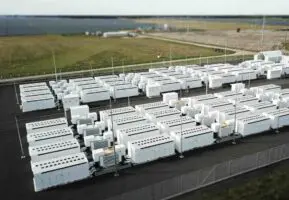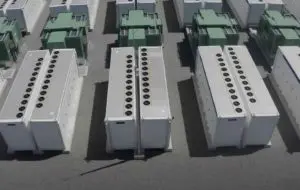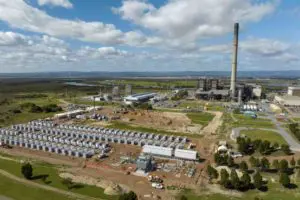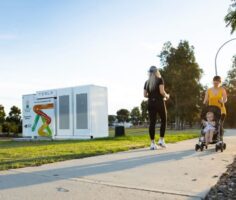EnergyAustralia has released the details of its proposed first pumped hydro project – most of which will now be hidden from view – as it seeks to fast-track its big battery plans and lock in its first giant battery in Victoria.
The energy utility has been busy contracting a range of different storage projects in recent years – including the Gannawarra and Ballarat batteries in Victoria, the Darlington battery in NSW (pictured above), and the Kidston pumped hydro project in Queensland – but is now embarking on a multi-billion plant to build its first facilities.
It has had a crack at pumped hydro before, but a proposed salt-water fed facility at Cultana in South Australia did not stack up, so its attention has turned to Lake Lyell near Lithgow in NSW, which supplies the Mt Piper coal plant and used to provide the cooling waters for the now shuttered Wallerawang coal generator.
In August, EnergyAustralia announced that it will move the proposed site of the top reservoir for the Lake Lyell pumped hydro project, and put the power station underground, after receiving feedback from the local community.
That plan has now been updated, with the top reservoir now being sited in a gully beyond the original ridge top – where it will not be visible from the majority of Lithgow – and the power station buried where it also will not be seen nor heard.
“Our engagement with the Lithgow community has provided invaluable information and feedback to the project,” says EnergyAustralia’s head of development Dan Nugent.
“The Plan released today provides additional detail to allow us to continue to consult and collaborate with them to optimise Project elements and ensure that adverse impacts are minimised.”
Nugent says the round trip efficiency of the project has not been greatly affected by the changes because of its proximity to the lake, which will act as the bottom reservoir.
EnergyAustralia hopes to complete environmental studies in the next six months and then seek planning approvals, with the view to making an investment decision in 2025 for the project, which will be likely sized at 335 MW, with eight hours of storage.
Pumped hydro, however, has proven difficult to build with only the Kidston project getting underway apart from the government funded Snowy 2.0, which has drawn controversy over its economic and environmental credentials, and is now running well behind schedule and well over budget.
The prospects for such projects will likely depend on the state and success of the federal government’s hugely expanded Capacity Investment Scheme, just as they will for battery storage.
EnergyAustralia is also developing a 350 MW, four hour battery at Wooreen in Victoria, not far from the Yallourn brown coal generator that will close in 2028.
Nugent says the Wooreen project will be submitted to the first round of the newly expanded Capacity Investment Scheme that will focus on Victoria and South Australia projects.
Registrations for that first tender close on December 15, although the exact design of the CIS has not been finalised.
The federal government has proposed a complex system of price floors and price collars, but the energy industry is keen to ensure there remains enough room to motivate bilateral contracts and for developers to accept some market risk.
That first tender will seek around 600 MW of capacity, with an average of four hours storage, with 200 MW nominally to go to each of Victoria and South Australia, and another 200 MW to the next best project. Wooreen would grab a large part of that capacity if successful.
Nugent says EnergyAustralia would like to reach financial close on the Wooreen battery in early 2024, and follow that with investment decisions in 2025 on a big battery at another of its fossil fuel generators, the Hallett gas plant in South Australia, and next to Mt Piper in NSW.
The CIS is being expanded from a total of 6GW (average four hours storage) to 9 GW, with a further 23 GW of wind and solar capacity.
The plan is currently to roll out a series of twice-yearly tenders from next year to complete the process by 2027 to ensure the projects are built by 2030, and help meet the government’s 82 per cent renewable target, crucial for its plan to cut emissions by 43 per cent below 2005 levels.











